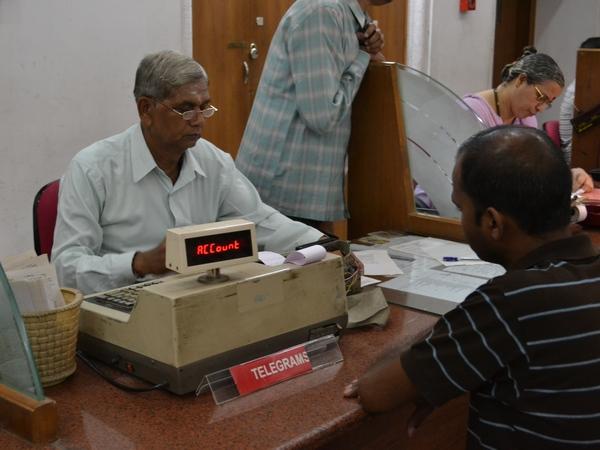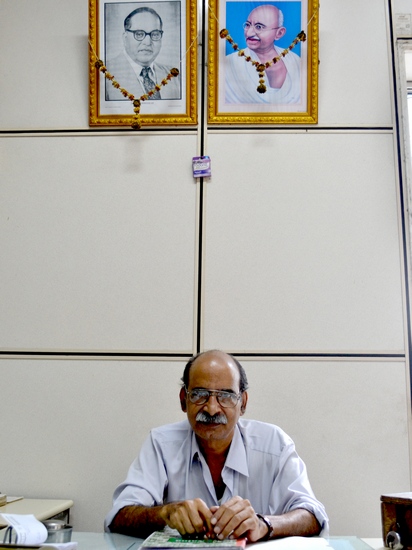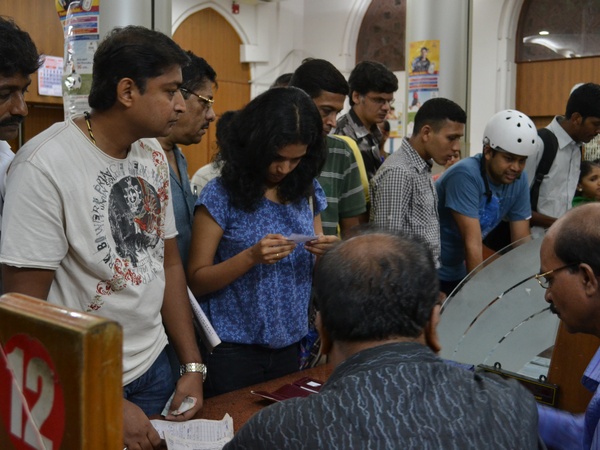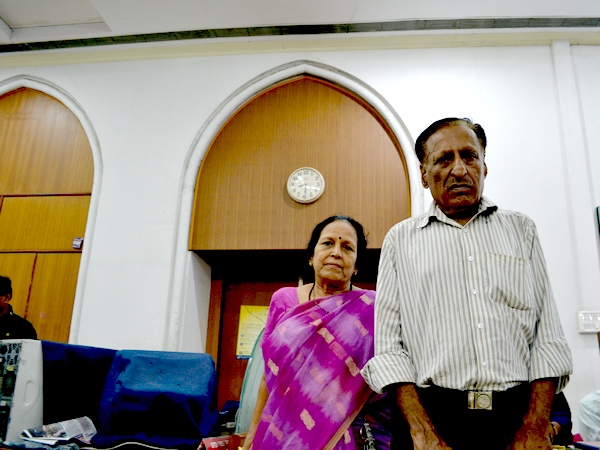
The 163-year-long service drew to a close. Abhishek Mande was there to record its final hours at Mumbai's Central Telegraph Office. Photographs: Nadisha Daniel
On Sunday, July 14, CN Deshmukh boarded his regular CST-bound local train with a heavy heart. For decades now he's been travelling from Dombivali, a distant suburb of Mumbai, to the Chhatrapati Shivaji Terminus to report for work at the Central Telegraph Office (or CTO).
Having served the organisation for over 38 years, Deshmukh is one of the oldest hands at the office, which suddenly found itself buzzing with activity as the 163-year-old telegraph services drew to a close on Sunday.
The five-feet-something Deshmukh with his bushy moustache cuts an imposing figure as he presides over the Instrument Room (or IR) of the CTO. As the senior telegraph master, he is responsible for sending out the telegrams that are booked at the CTO.
While at its peak, the telegraph room was out of bounds for everyone except the select few telegraphists who worked there. Deshmukh was one of them.
"Now it's all over," Deshmukh says. "It doesn't matter now."
School students walk around, in a single file of course as the staff tells them about a legacy they may never be able to comprehend; television news reporters, armed with their PD cameras thrust their microphones at every second person walking into the room; colleagues and friends come by to shake hands and bid goodbye.
For most part, the room is empty and is being occupied by a handful of employees. By now, it has acquired the ambience of a hall that has just seen the close of a grand party.
And what a party it has been!
Please ...

At its peak in the mid-1980s there were over 45,000 telegraph offices all over the country with more than six lakh telegrams being dispatched each day.
Everyone at the office recollects the time when thousands of telegrams would be sent every day.
Our messengers have delivered telegrams even during riots and floods, Ganesh Shanker Gaur, a sub-divisional engineer employed at the CTO says. Gaur is a Class 2 officer an evidently slightly higher up in the pecking order as Deshmukh.
Unlike his subordinate, Gaur hasn't been a telegraphist and has been part of the CTO workforce only for a few years. Even though he has been standing by his staff on this last day, and seems like a nice enough fellow, Gaur gives you the impression that he isn't really affected by it. For him it is probably just another posting.
This isn't the case with Deshmukh. He's always been in the trenches and much of this is really personal to him. "Sending telegrams is what we've done all our lives. We lived for this. Now we won't be doing it anymore. I felt strange this afternoon when I took the train to come to work," he says, the smile vanishing from his face.
"At one point, an entire floor was filled with Hindustan Teleprinting machines. We would work non-stop. It was like a mill. You could hear the sound of the keys all the way up to Churchgate station (a little over 500m away)."
That's another thing you miss in the office.
Many who walk into the IR expect to see women and men hunched over Morse code machines tapping away the brass instruments, sending out messages. "Those have stopped in the '80s," Gaur informs. "The teleprinters came after that and stayed for a long time. The keys on the printers used to be very hard. People who worked on them would have really hard fingertips and their fingers wouldn't be as flexible as ours are. Some of them would have difficulties holding a pen!"
Some time in the mid-noughties, in a strange case of the old meeting the new, the Web-based telegraphy message system (or WTMS) came about and the telegraph officials began using the Internet for delivering messages. (You can watch how it works here!)
Yet another official, who identified himself as Sawant, recollected the time when they would have a kiosk at the Wankhede stadium during all the important cricket matches. "And there was one at the State Bank of India's Fort office too meant exclusively for the bank's dispatches."
Dispatches from banks were coded, he adds. "We would never know what they meant. They were just a combination of letters and numbers. Messages from Reserve Bank of India would appear on yellow papers. They were called clear line messages, which meant they got priority. And you had to be very, very, very careful with them."
The IR, much like the newsroom, is supposed to be a zero-error zone. "One mistake and your increment would be stopped for six months to a year," CN Deshmukh says. "A friend once took a clear line message and had to make a change in the amount mentioned in it. He pasted the new amount on top of the old one and sent it out. The next thing we heard was that his increment was stopped for a full year. Apparently the old figure had reached the receiver. We discovered later that the gum had come off but the damage was done."
Please ...

CN Deshmukh doesn't send messages anymore but he recollects the time when he used to. He recollects his moment of glory with some pride.
It dates back to 1986 when the Maharashtra government appointed the Justice Lentin Commission after 14 patients died in JJ Hospital of acute renal failure due to substandard medicines between January 21 and February 17 that year.
"Every day the commission would send out lists of medicines that had to be banned across the board. That message had to be relayed to all the important hospitals in the state. One particular day the pressure was really high. I started sending out telegrams from 3.30 pm and completed my job at 7.30 pm. In four hours I had sent 760 messages!"
***
The quiet of the IR is most felt when you push the door and walk into the customer service section on the other side. While on most days you would find it difficult to tell the difference, what with the dwindling number of orders, the last day in the history of the telegram would be another story altogether.
At any given point from about 4 pm, there were a little over 150-200 people in the room that had evidently not seen so much action in the last decade or so. Most, like 17-year-olds Anish Gawande and Sanaya Patel were debutants who'd set out of their homes with the express purpose of sending out telegrams as souvenirs. Others such as Jeenendra Bhandari remembered the day while he was cycling in the area and decided to drop by, in his helmet and riding shorts!
Even others such as Dr Ashok Kriplani and Mahendra Singh came by only to relive their memories. Like everyone of a certain vintage, they spoke about telegrams being a harbinger of extreme news. "You knew it had to be something either very good or very bad," Kriplani said.
Singh counts a particular telegram he sent his father as his most memorable. "I told him I was selected to be part of the Officers Training Academy. It was on July 21, 1969… the same day as Neil Armstrong landed on the moon."
Kriplani remembers the day he got his job offer at Mumbai's JJ Hospital via telegram but confesses that the one telegram-related story he'd never forget was the one that came from his uncle.
"One of my uncle's employees had gone on leave for longer than usual which got him worried. After some days he received a telegram from him: 'Getting wife with kids'. My uncle cheekily replied: It would be a good idea to marry her and save you the trouble'."
Please ...

Among the early birds on Sunday were the Damania couple who sent out telegrams to their teenaged kids for their 'memory box'. Entrepreneur Parvez Damania looked bemused by the whole affair took some time to come to terms with how the office he visited as a child now looked. "It is something else altogether," he said, adding with an equal amount of disbelief the ingenuity of his lawyer who served a notice via telegram! "There was no way he could refuse it!" he chuckled.
The star of the day, however, was a young advertising executive, Nitin Rastogi, who walked into the premises with an order of 4150 telegrams on behalf of his client, the insurer Birla Sun Life giving them business of over Rs 1.6 lakh single-handedly on the last day.
As the hours ticked by, the crowd increased manifold. At 6.25pm, one of the National Cash Register machines failed and technicians had to step in to fix it. The scene was repeated an hour or so later.
At one point it seemed like things would get out of hand. A rather rude young man had begun to lose his patience and despite all efforts refused to calm down. More counters were opened and the crowd began to thin. It seemed evident that the last orders would go way past the 8 pm deadline.
Among those queuing up was Mahendra Tarwala, who claimed that telegrams were a source of income for him. "I live off the commission I make by sending telegrams on behalf of traders. I don't know what I'll do now," he said as he wept profusely.
Tarwala, a known figure in the office, stuck around till the very end. One of his telegram messages were purposely kept on hold so he could be among the last people to send it out. The message was to a trader complaining about the poor quality of tuvar dal.
Watch Tarwala narrate his story here!
Please ...
As the hour hand inched past 9.30 pm Vaishali Kardhekar, the PRO, announced that no orders would be taken after 10 pm. For what it was worth the telegram had received a lifeline of a few more hours.
By now, the number of telegrams for the day had crossed 8,000 and the office had done business of over Rs 5 lakh, Kardhekar informed.
The crowds had thinned out and the only people waiting were those who wanted to be part of history. Customers who were crowding to reach the counter now began to turn away from it to return to the tail of the queue.
Kardhekar was literally driving people to the only functioning counter. A handful of journalists left behind waited for the moment that finally arrived.
Nitin Rastogi, the ad executive, had scored a win yet again. His last message went out to his client, Ajay Kakar at Birla Sun Life Insurance thanking him for being a 'great client'.
Khadekar held up the telegram and choked up as she announced the closing of the service.
The machine registered the booking of the final telegram at 22.13 hours IST. And then was shut down forever.